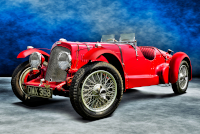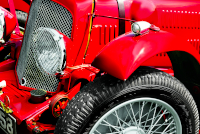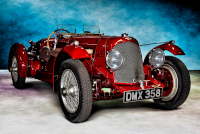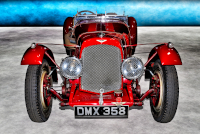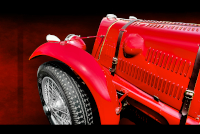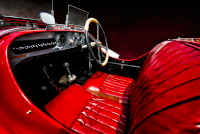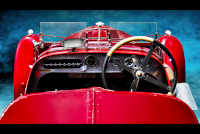Location:
Simeone Foundation Automotive Museum Demo Day, 2023
Radnor Hunt Concours d'Elegance, 2013
Owner: Simeone Foundation Automotive Museum | Philadelphia, Pennsylvania
Prologue:
Difficult to see what this car is at a glance, LM22 looks inconspicuous—not as pretty as an Ulster, not as handsome as a Speed Model. With only two built, perhaps we can be excused our ignorance. Better had the exhaust side been clear for photographs at first glance, as most of the interesting bits happen over there. For my part, I framed a few tight compositions in 2013. The cluttered nose composition I like. But the bonnet shot landed the tip of the cycle fender a foolish fifteen pixels from the edge, so I extended the canvas and finished the piece at 28.1 MP. The 2013 show at Radnor Hunt is the only show at which I used a D600, and I did not entirely adjust to the lenses or sensor. Working with E's shots on the old D200, I shifted and stitched together a number of different shots for cleaner compositions. Most notably, for Photo 8 looking over the tail, I stitched together two of E's shots to resolve differences in depth of field between dashboard and deck. Perhaps I could have taken a closer look myself, but I'm glad she took up the slack.
Ten years down the road I picked up a decent quarter perspective on the exhaust side, and the basic fascia; these are the first images to test the dim lighting at the Simeone Foundation, which will play a large role in a few automobiles we can survey in depth. So overall, we've compiled an ungainly hodge of podges, though I'm steadily improving the lot.
- - - - - - - - - -
► Image Source 1-2, 5: Nikon D600 (24.3 MP), 2023 | Image Source 3-4: Nikon D750 (24.3 MP), 2013
Image Source 6-10 by E, illustrated by the author: Nikon D200 (10.2 MP), 2013
References:
- The Autocar: June 12, 1936, "Aston Martin's New 2-Litre, Interesting Development of a New Super-Sports Model for the Enthusiast" page 25
- Motor Sport Magazine: July 1937, "A 2-Litre Aston-Martin (sic), Striking New Super-Sports Model which should Give Speed of 110 M.P.H in Le Mans Trim" p.357, 363
- Simeone Foundation Automotive Museum: Home of this rare Aston Martin, the museum offers lovely exhaust-side photographs and personal history, though the technical data may be questionable.
- Ecurie Bertelli: Excellent history and technical information provided by early marque specialists.
- AstonMartins.com: A summary of the 2 Litre team cars, with photos of LM23.
- Bonhams: The Red Dragon Aston Martin 2-Litre Speed Model represents Aston's classic development of the new 2-litre formula.
- RM Auctions: A beautiful 1939 Aston Martin 2-Litre Brooklands Speed Model demonstrates late 2-litre development.
Aston Martin appear to have completed LM22 after LM23, whence it received its DMX 358 registration. The serial number is G6/701/UR. Having been completed first, car G6/702/UR (now known as LM23), received DMX 357. Both cars survive, and both retain their original registrations. According to the Simeone Foundation Automotive Museum, LM22 received the first of the new 2-litre motors. The car raced through the early post-War period, traveled to the US, and continued work at time trials, slaloms, and sprint events into the early 1980s. During its career, LM22 received new paint and mechanical refurbishment, but remains today in original, unrestored condition.
Geopolitical Influence on Le Mans in the Classic Era
France, 1936, marked a point of turmoil leading up to World War II. A general strike led to a labor government, active for a few years, able to advance social reforms through the Matignon Agreements. Reforms included collective bargaining, paid vacation, and a 40-hour work week. However, inflation stemming from the Great Depression offset wage increases, and industry stagnated in the years preceding war. The story speaks to a weakened economic state at a time when Germany and Italy funded technology to standards that would not be reached again until much later in the century. Still, Le Mans remained a focal point of Anglo-French concern, and Aston Martin had finished third overall in 1935 with the 1½-litre Ulster.
Sutherland's Development of the New Aston Martin 2 Litre
With the target of capitalizing on the 1½-litre's promise, R. Gordon Sutherland—son of Arthur Sutherland, the owner who had taken over from A C "Bert" Bertelli—put a new 2-litre four-cylinder motor into development. The result turned out to be a completely new car. The 1½-litre block couldn't accommodate a longer stroke, and since the company decided on developing a new motor, a new chassis followed. With the new chassis came a new front axle assembly, new gearbox, and Aston Martin's first hydraulic brake system, developed largely in-house. Aston Martin completed two team cars for Le Mans, known today as LM22 and LM23. But, as the strike scuppered that year's race, the company sold both to help recover development costs.
Having planned a run of 25 new 2-litre cars, the remaining 23 chassis became known as the 2 Litre Speed Model. Aston sold these race-bred cars over the next four years. Development continued throughout the limited production run, and the cars donned a wide variety of sporting body styles.
As for the two team cars, LM22 and LM23 represent the transition from the Bertelli cars (the 1½-litre International and Ulster) and the Sutherland cars (the 2-litre Speed Model and 15/98).
Motor: 1,949 cc straight 4-cylinder, cast iron block with three main bearings | 69.3 mm x 99 mm
According to Ecurie Bertelli, the 1½-litre could be bored to over 1,700cc, but without much gain in performance; neither could the stroke be easily increased. These considerations spurred development of a new motor. Intake and exhaust flow also switch sides between the 1½ and 2-litre motors, which provides an easy means of differentiating between Bertelli and Sutherland cars.
Valvetrain: SOHC, 2 valves per cylinder, driven by reduction gears and a roller chain
Use of the gear-to-chain drive allows the head to be serviced without the need to re-adjust the timing.
Aspiration: twin SU carburetors
Power: 110 bhp @ 5,500 rpm (estimated)
Drivetrain: 4-speed gearbox, rear-wheel drive
The gearbox is a crash unit, (straight-cut gears), built for racing. Ecurie Bertelli write, "Bert Bertelli and Claude Hill understood that all racers needed to do was get into the next gear as quickly as possible, and by far the best method of doing this was to double de-clutch going down the box and simply ‘smash it in’ going up. Strong straight-cut gears with a simple selector mechanism were ideal for the job. In publicity material the ‘racing type gearbox, designed for lightning changes up or down’ was particularly featured. One of the joys of driving a good Speed Model is still, to this day, using its gearbox." The clutch is a single-plate Borg & Beck unit, the UK company producing parts using American patents.
Front Suspension: beam axle, semi-elliptic leaf springs, friction dampers
Aston Martin purchased a unit designed by Alford and Alder, which allows the axle to pivot with a controlled amount of play, designed to minimize changes in steering geometry during braking and cornering. Originally, cables fixed to the frame located the axle, creating an adjustable unit. However, the original design proved instable under cornering forces, so Aston Martin replaced the cables with a solid rod. Also, the 2-litre's friction dampers sit outside the springs, mounted inline with the frame, as opposed to the 1½-litre Ulster's transverse dampers.
Rear Suspension: live axle, semi-elliptic leaf springs, friction dampers
Architecture: steel channel-section frame with cross-member bracing
Wheelbase: 2,590.8 mm (102 inches), or 3,048 mm (120 inches) for the touring car
Top Speed: 177 km/h (110 mph), based on 104 mph at 5,500 rpm, with an allowable crank speed of 6,000 rpm
Etymology:
In 1936, Aston Martin developed its mainstay 1½-litre 4-cylinder into a 2-litre package, completing two works cars for Le Mans. Colloquially known as, LM22 and LM23, neither car raced for the works team following cancellation of Le Mans that year.
Note that 'Aston-Martin' used a hyphen from 1914 to 1926, and also from about 1932 to the second World War. Use of the hyphen seems to depend on who owned the company at the time. For continuity, and to avoid confusion, I simply omit the hyphen.
Figures:
Aston Martin planned 25 2-litre cars, built two for Le Mans in 1936, but sold them both without having run either as a works car, (again, owing to the Le Mans cancellation). The remaining 23 chassis became the 2 Litre Speed Model, delivered from 1936 to 1939.
Value:
Cost in 1936 for the short-chassis car was £800, or £875 with coachwork.
Spritely Stance: Sporting Posture of the New Aston Martin 2 Litre
The way LM22 sits high on its front springs creates a leap-forward attitude. The shape itself takes cues from the 1½-litre cars, with a tombstone radiator shell and tapertail body. However, the 2-litre cars fix each front cycle fender to the frame, a more conventional configuration than the Ulsters, whose front fenders turned with the wheels. Aston Martin also conceived a cowl for the dumb irons, concealing the suspension components and smoothing airflow around the base of the grille.
At some stage, LM22 lost its cowl, and being otherwise preserved in original condition, would not receive a replacement. LM23 retains a cowl as originally designed. Most of the 2 Litre Speed Model cars that followed look more sophisticated still, ranging from sharp, cycle-fendered cars to fully enclosed early steamliners. In this sense, the 2 Litre team cars resemble their 1½-litre forebearers, (apart from the intake-exhaust side switch) even though mechanically speaking they are the earliest of the Speed Model cars.
Le Mans: Design Concessions to Le Mans Regulations
An apparent two-seater, the 2 Litre team car meets Le Mans regulations for a four-place configuration with an enclosed passenger compartment. The curved plate over the back deck hides this passenger compartment while reducing drag. A piano hinge down the middle allows stowage access from either side. The headlamp screens hint at endurance racing intentions, as does the minimalist coachwork, still straight and rather utilitarian.
Changes in the front axle widened the car's attack, which, combined with the four-place length, creates a larger car than the nicely proportioned 1½-litre Ulster. We only managed intake-side photos, whereas the clutter of the exhaust and steering box down the right flank actually liven up the appearance, occupying the wheelbase with winding pipes and intriguing gouges. On the intake side, the bulge in the bonnet appears to give the lead SU carburetor extra clearance, given how the nose narrows toward the grille.
Effective Stop: Early Aston Martin Hydraulic Brake System
20 years before Jaguar became known for its disc brake system at Le Mans, Aston Martin developed a fault-tolerant hydraulic braking system, separating front and rear brake circuits, and fitting massive aluminum alloy drums with cast iron liners. At great cost, the factory developed most of the system in-house, sourcing only a few parts from Lockheed. If somewhat underpowered compared to more exotic competition, the combination of brakes, gearbox, suspension, and chassis give the 2-litre cars an excellent reputation for road-holding.
Last Updated: Mar 26, 2025

